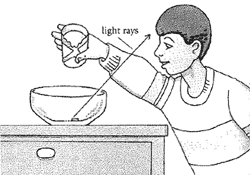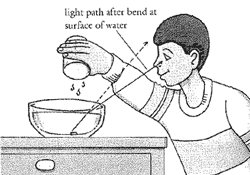Make Money Appear Before Your Eyes

Required Materials
An opaque cup or bowl
A piece of transparent cellophane tape
A coin
A glass of water
Activity Directions
- Tape the coin securely to the bottom of the inside of the cup or bowl.
- Move your head slowly away (back) from the cup until the coin is just beyond your view.
- Hold your head in this position as you carefully pour the water into the cup.
- The coin will reappear before your eyes.
Hereís Whatís Happening
You canít see the coin because some of the light rays that come from the coin are blocked by the cup and the rest of the rays from the coin go above your eyes. When you put water in the cup, the light previously hitting your forehead bends down toward your eyes, and the coin comes into view.
Thinking of Light as Waves

Scientists could not explain some of the behavior of light by thinking about it as being made up of streams of particles. So they invented another way of thinking about light, describing it as being made up of waves. Itís worth a little effort to think about what a wave is. If you drop a pebble into a still pond, the pebble causes waves that travel in ever-widening circles from the disturbance. The high point of each wave is the crest; the low point between crests is the trough. The distance from one crest to the next or from one trough to the next is called the wavelength. A wave is started by a pulse of energy, and it travels through time and space. Water waves are only a model for light waves. Light waves are similar to water waves because they are also made up of crests and troughs, but light wavelengths are ten million times smaller than water wavelengths. And light doesnít need a medium, like water, to travel through. Light travels through the vacuum of space.
Refraction can be explained if we think of light as being made up of waves. In the preceding experiment, when a wave of light from the coin reaches the water-air boundary at an angle, one part of the wave enters the air before the other parts. This part of the wave speeds up because light travels faster in air than in water. The other parts of the light wave that are still in the water are traveling at a slower speed than the part in the air. This happens to each part of the wave as it leaves the water, and this change in speed causes the light to bend.
Hereís another way you can think about this. Imagine that you are with ten of your friends at the beach, and you all stand in a row to race toward the water. If you all ran toward the sea at the same speed and reached the water all at the same time, the water would slow all of you down at the same moment. But suppose that your lineup heads for the water at an angle. Jim, your friend on one end of the line, reaches the water before Kristin, who is standing next to him. And Kristin reaches it before the friend next to her, and so on. As each person hits the water, he or she slows down. By the time everyone is in the water, the whole line is running more slowly in another direction.
This is what happens to light waves: If the light meets a boundary between two materials head on, it will pass from one to the other without changing direction. When it strikes the boundary between transparent materials at an angle, it refracts.
Want to Learn More? Read an article related to this activity:
To find this experiment and many more please read Light Action! Amazing Experiments with Optics by Vicki Cobb and Josh Cobb, illustrated by Theo Cobb. To purchase a copy click here.









